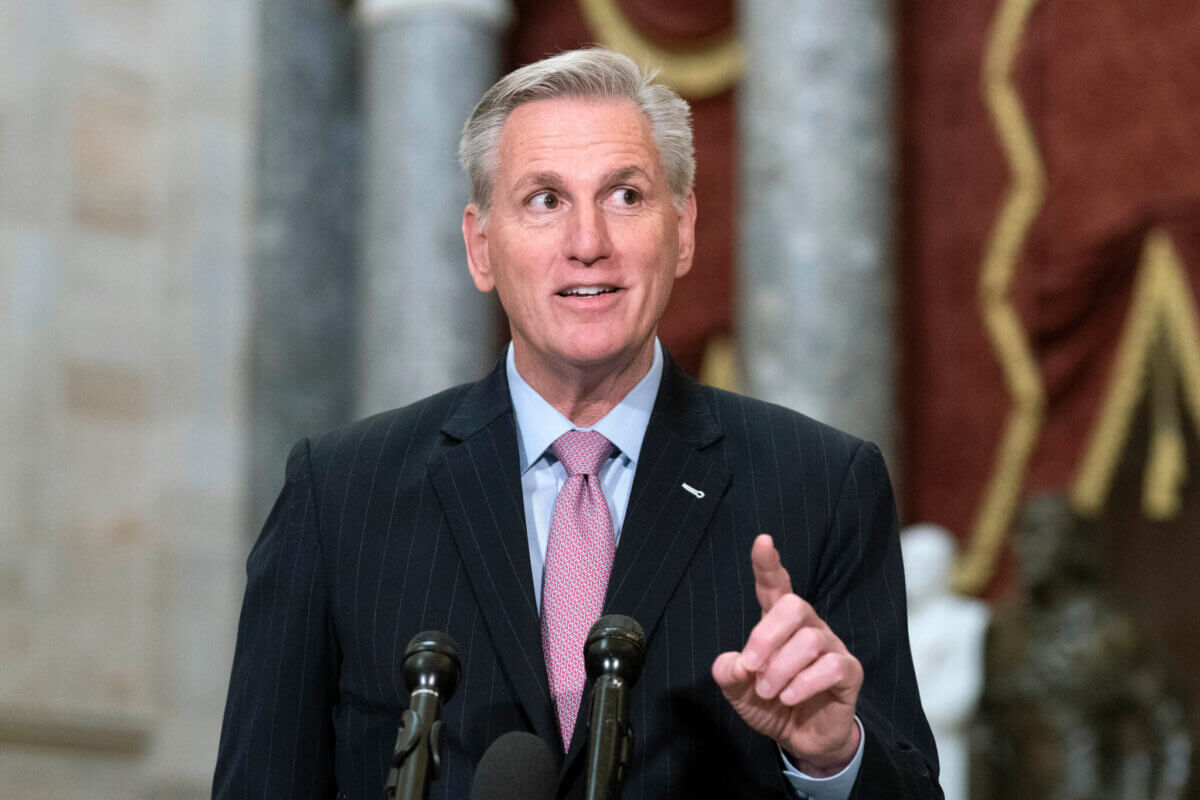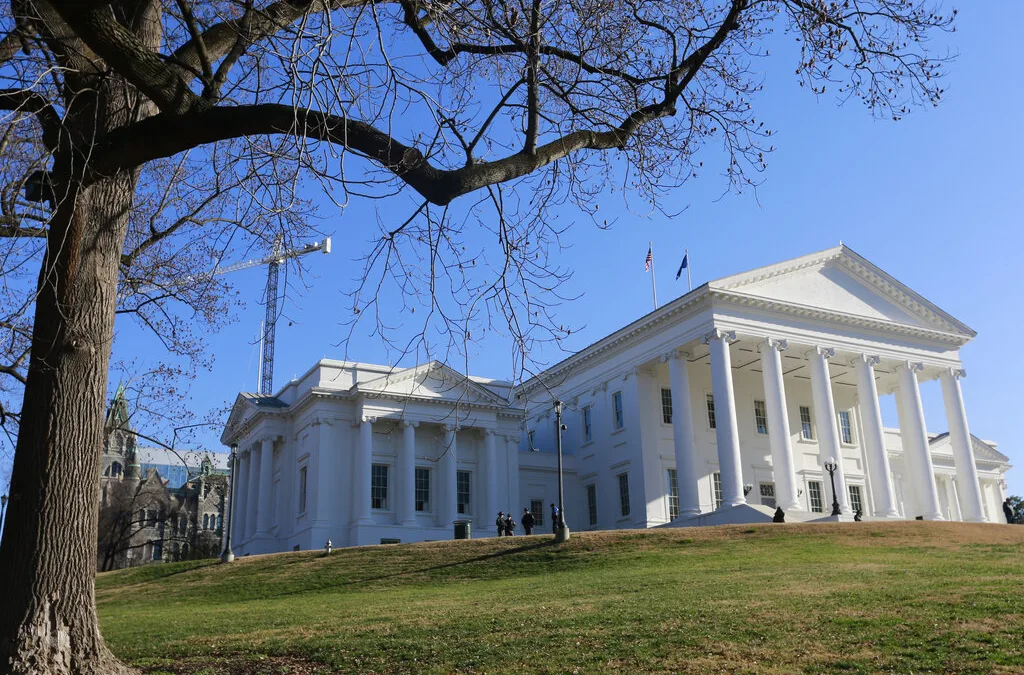
Speaker of the House Kevin McCarthy, R-Calif., speaks during a news conference in Statuary Hall at the Capitol in Washington, Thursday, Jan. 12, 2023. (AP Photo/Jose Luis Magana)
The debt ceiling is a numerical limit, set by Congress, on how much money the federal government can borrow to pay its bills. Increasing the debt ceiling is a routine congressional task, but Republicans want to hold it hostage to make cuts to Social Security and Medicare, even though failing to raise the limit would cause massive economic devastation.
Six million job losses, $15 trillion in American household wealth wiped out, 401k plans decimated, 9% unemployment, cuts to Social Security and Medicare, and a federal government that can’t fund Medicaid, food safety inspections, border control, or air traffic control—that’s what House Republicans could inflict on the United States this year.
If that sounds too crazy and extreme to be true, we get it, but it’s not: In order to become House Speaker on his 15th attempt, Rep. Kevin McCarthy of California agreed to a request from the most extreme members of his party that House Republicans would oppose raising the debt ceiling unless Congress cuts $130 billion or more in spending next year, or an 8% cut from the most recent spending bill, just passed in December.
MAGA Republicans have made clear they want these cuts to come from programs like Social Security and Medicare and that they intend to use the upcoming debt ceiling negotiations to try to force cuts to these crucial programs that protect tens of millions of working- and middle-class families from poverty and precarity—even if it means pushing the economy to the brink of collapse.
Here’s what you need to know:
The Debt Ceiling: What Is It?
The debt ceiling is a numerical limit, set by Congress, on how much money the federal government can borrow to pay its bills.
Most years, the federal government spends more than it takes in in taxes, so it has to sell Treasury debt and use that borrowed money to cover the difference and pay the country’s bills, up to the limit set by Congress. When the government reaches that borrowing limit, Congress can either raise the debt ceiling or vote to suspend it for a specific period of time, allowing the Treasury Department to borrow as much as it needs.
Increasing the debt ceiling is a routine congressional task and was an afterthought for decades. Congress has raised the debt ceiling 78 times since 1960—nearly once a year, because failing to raise the limit would cause the US to default on its debt, triggering a global financial crisis.
But over the past decade, as Republican politicians have become more extreme, they’ve repeatedly tried to use the debt ceiling to force cuts to essential programs like Social Security and Medicare. In 2011, Republicans brought us close to a debt limit crisis to try to extort concessions from former President Obama. A deal was reached in time after Obama agreed to across-the-board spending cuts, though this did not include cuts to Social Security. Despite the agreement, the uncertainty and chaos Republicans imposed on the nation led to America’s credit rating being downgraded for the first time in history.
This year, Republicans appear once again to be eager to push the country to the brink of default. Unless Democrats agree to cut spending, Republicans have said they won’t agree to raise the debt ceiling.
Why? What Do Republicans Want?
Republicans claim that the government needs to cut spending and reduce the national debt in order to be fiscally responsible, but these very same lawmakers recently voted to add $114 billion to the deficit by voting to repeal IRS funding that will allow the agency to pursue super-wealthy tax cheats.
Many of these lawmakers were also avid supporters of the Trump administration, which oversaw a debt increase of nearly $8 trillion, due in large part to Trump’s 2017 tax cut, which primarily benefited the wealthy and big corporations.
There are other ways Republicans could reduce the deficit. They could, for example, opt to raise tax rates on the very wealthy, which would help the government take in more revenue and therefore decrease what it needs to borrow. But Republicans oppose such tax hikes on the rich and in fact have repeatedly slashed taxes on corporations and the very wealthy since the 1980s. Some Republicans are so opposed to the idea of the wealthy paying a reasonable amount of taxes that they apparently forced McCarthy to agree to introduce a bill that would completely eliminate the income tax and abolish the IRS, replacing it with a national sales tax instead.
The reality is, Republicans want to cut Social Security and Medicare because they have long been ideologically opposed to the programs and have repeatedly tried to make cuts to them, even though their position is exceptionally unpopular among voters, including Republican voters.
President Biden and Democrats in Congress have refused to make such cuts and instead support passing a law to raise the debt ceiling without cutting Social Security and Medicare.
“There should be no political brinkmanship with the debt limit. It’s reckless for Speaker McCarthy and MAGA Republicans to try and use the full faith and credit of the United States as a political bargaining chip,” Democratic Sen. Majority Leader Chuck Schumer of New York said in a statement this week. “A default would be catastrophic for America’s working families and lead to higher costs.”
What Would Happen if Congress Doesn’t Raise the Debt Ceiling and the US Defaults?
Within a week, the US would be unable to pay more than 60% of its bills and would plunge into a recession. As many as 6 million jobs and $15 trillion in household wealth could be destroyed if there’s a drawn-out dispute over the debt ceiling, and the unemployment rate could reach 9%, according to Mark Zandi, chief economist at Moody’s Analytics. And even the threat of default could raise interest rates, harming anyone who needs to take out a loan to cover car payments, mortgages, or business costs.
“They’re threatening to kill millions of jobs and 401(k) plans by trying to hold the debt limit hostage unless they can cut Social Security, cut Medicare, cut Medicaid,” White House press secretary Karine Jean-Pierre said on Wednesday.
When Will We Pass the Debt Ceiling?
Technically, the US passed the debt ceiling on Thursday, but the Treasury Department has said it will take “extraordinary measures” to ensure that the federal government has enough money to pay its bills. These measures include suspending certain types of investments in savings plans for government workers and temporarily moving money between different government agency accounts to stay under the borrowing limit.
Treasury Secretary Janet Yellen projects that these measures will help stave off a crisis until early June but urged Congress to act immediately to raise the debt ceiling.
“The period of time that extraordinary measures may last is subject to considerable uncertainty, including the challenges of forecasting the payments and receipts of the U.S. government months into the future,” Yellen wrote in a letter to Congress. “I respectfully urge Congress to act promptly to protect the full faith and credit of the United States.”
Are Republicans Really Willing to Destroy the Economy?
It appears that way. As the Washington Post reported, Republicans are already working on a plan—which was part of McCarthy’s concession to the most extreme Republicans during his quest to become Speaker—that would direct the Treasury Department to prioritize certain payments, such as interest on debt payments, Social Security and Medicare, and veterans benefits, in the event of a debt ceiling breach.
But such a plan would leave out funds for an enormous array of crucial federal programs, such as Medicaid, the Affordable Care Act, food safety inspections, school lunch programs, border control, drug enforcement, air traffic control, and much more.
The Democratic-led Senate is almost certain to block such a proposal, but the idea shows that MAGA Republicans appear willing to force economic misery and complete chaos on tens of millions of Americans.
The idea is so controversial and toxic that several conservatives have already criticized it, with a former staffer for ex-Republican Sen. Rob Portman of Ohio calling it a “really bad idea.”
What Now?
The Biden administration and Democrats are standing strong and refuse to cut Social Security and Medicare, while Republicans want to put the programs on the chopping block, and are willing to hold the debt ceiling hostage in order to get what they want.
This suggests a months-long showdown with nothing less than the American economy and the livelihoods of millions of workers at stake.

VIDEO: Your support matters!
Your support matters! Donate today. @vadogwoodnews Your support matters! Visit our link in bio to donate today. #virginianews #virginia #community...

Op-Ed: Virginia’s new Democratic majorities pass key bills to improve your lives, but will Youngkin sign them?
The 2024 Virginia General Assembly regular session has wrapped up. It was a peculiar session from the outset, with Democratic majorities in the...

Op-Ed: Why Virginia Needs A Constitutional Amendment Protecting Reproductive Freedom
Virginia’s recent election season in 2023 drew in eyes from all over the country. Reproductive freedom was on the line and Virginia remained the...

From the state rock to the state flower, here’s how Virginia got its symbols
Have you ever wondered why the Dogwood is the state flower? Or how the cardinal became the state bird? We’re here to answer those questions and more...

VIDEO: Second-gentleman Douglas Emhoff gives speech on reproductive freedom
Second gentleman, Douglas Emhoff touched on reproductive freedom not only being a woman's issue but "an everyone's issue" during the Biden-Harris...

Glenn Youngkin and the terrible, horrible, no good, very bad night
Election Day 2023 has come and gone, and while there are votes to be counted, one thing is perfectly clear: Virginians unequivocally rejected Gov....




